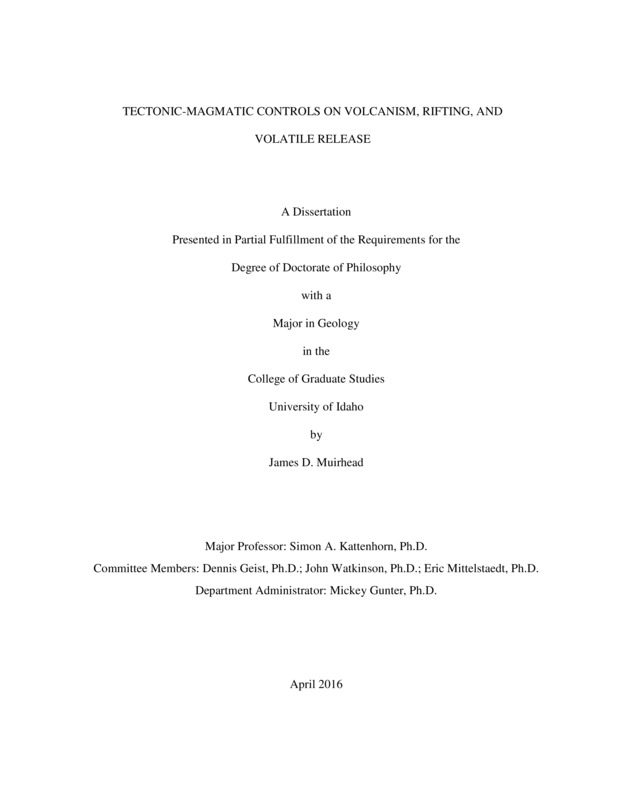Tectonic-magmatic controls on volcanism, rifting, and volatile release
Muirhead, James. (2016). Tectonic-magmatic controls on volcanism, rifting, and volatile release. Theses and Dissertations Collection, University of Idaho Library Digital Collections. https://www.lib.uidaho.edu/digital/etd/items/muirhead_idaho_0089e_10919.html
- Title:
- Tectonic-magmatic controls on volcanism, rifting, and volatile release
- Author:
- Muirhead, James
- Date:
- 2016
- Embargo Remove Date:
- 2018-05-19
- Keywords:
- continental rifting dike fault large igneous province magmatic volatile volcano
- Program:
- Geology
- Subject Category:
- Geology
- Abstract:
-
This dissertation examines the interplay between tectonic and magmatic processes that influence the nature of volcanically active regions. In particular, I address how faulting, fluid transport, and magma intrusion interact in a variety of settings, including continental rifts, large igneous provinces (LIPs), and monogenetic volcanic fields.
In the East African Rift (EAR), I combine structural measurements and field observations with geochronology, geochemistry, and seismicity data to investigate how continental breakup initiates and evolves. Analyses of volcanic cone lineaments illustrate variations in the geometries and distributions of dike intrusions along the rift. In early stage basins (<10 Ma), upper crustal dikes are confined to transfer zones – then, as rifting progresses (>10 Ma), dikes begin to accommodate extension along the entire length of the basin.
Measurements of diffuse gas flux in the EAR demonstrate that significant volumes of magmatic CO2 (>4 Mt yr-1) are rising along faults from upper mantle/lower crustal magma bodies. Over the entire EAR, this tectonic degassing (~71±33 Mt yr-1) contributes significantly to Earth’s natural CO2 budget. Moreover, the release of magmatic volatiles assists strain localization and the development of new rift segmentation within existing half-graben depressions. Newly developing segments become kinematically linked with existing rift segments through the reactivation of rift-oblique basement fabrics. Resulting transverse faults postdate rift-parallel fault systems, indicating that preexisting weaknesses play a critical role at all stages of rift development.
A regional synthesis of sill-fed dikes of the Ferrar LIP, Antarctica, and field and remote-sensing analysis of the Hopi Buttes volcanic field, Arizona, highlights the role of interconnected dike-sill systems in feeding eruptions. Measurements reveal a previously unrecognized feeder system to LIP eruptions––analogous to a “cracked lid” atop a sill network––that may be the archetypal model for LIPs that intrude sedimentary basins undergoing negligible regional extension. At Hopi Buttes, several characteristic shallow feeder systems are identified: (1) dike-dominated, (2) sill-dominated, and (3) interconnected dike-sill networks. Dike-fed eruptions are common, but sills also modulate the flow of magma toward and away from eruptive conduits, providing a novel mechanism for lateral vent migration and changes in magma-water ratios that lead to explosive volcanism.
- Description:
- doctoral, Ph.D., Geology -- University of Idaho - College of Graduate Studies, 2016
- Major Professor:
- Kattenhorn, Simon A
- Committee:
- Watkinson, John; Geist, Dennis J; Mittelstaedt, Eric
- Defense Date:
- 2016
- Identifier:
- Muirhead_idaho_0089E_10919
- Type:
- Text
- Format Original:
- Format:
- application/pdf
- Rights:
- In Copyright - Educational Use Permitted. For more information, please contact University of Idaho Library Special Collections and Archives Department at libspec@uidaho.edu.
- Standardized Rights:
- http://rightsstatements.org/vocab/InC-EDU/1.0/

